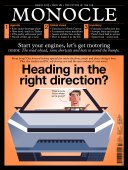
Issue 161
Is the future electric? That’s the question that Monocle is asking in its future of the car special. Our forward-looking report offers our verdict on self-driving cars, the auto industry’s next moves and the companies in pole position to take advantage. Plus: Australian architecture, Veja’s new office and Spam – no, really.
In This Issue
Oops! No content was found.
Looks like we no longer have content for the page you're on. Perhaps try a search?
Return Home

